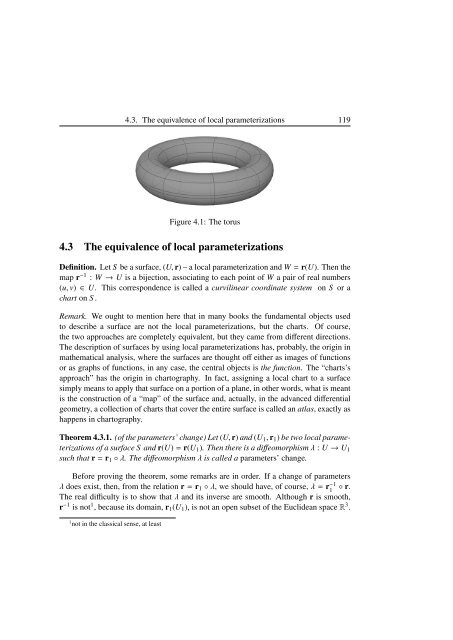Blaga P. Lectures on the differential geometry of - tiera.ru
Blaga P. Lectures on the differential geometry of - tiera.ru
Blaga P. Lectures on the differential geometry of - tiera.ru
Create successful ePaper yourself
Turn your PDF publications into a flip-book with our unique Google optimized e-Paper software.
4.3. The equivalence <strong>of</strong> local parameterizati<strong>on</strong>s 119<br />
Figure 4.1: The to<strong>ru</strong>s<br />
4.3 The equivalence <strong>of</strong> local parameterizati<strong>on</strong>s<br />
Definiti<strong>on</strong>. Let S be a surface, (U, r) – a local parameterizati<strong>on</strong> and W = r(U). Then <strong>the</strong><br />
map r −1 : W → U is a bijecti<strong>on</strong>, associating to each point <strong>of</strong> W a pair <strong>of</strong> real numbers<br />
(u, v) ∈ U. This corresp<strong>on</strong>dence is called a curvilinear coordinate system <strong>on</strong> S or a<br />
chart <strong>on</strong> S .<br />
Remark. We ought to menti<strong>on</strong> here that in many books <strong>the</strong> fundamental objects used<br />
to describe a surface are not <strong>the</strong> local parameterizati<strong>on</strong>s, but <strong>the</strong> charts. Of course,<br />
<strong>the</strong> two approaches are completely equivalent, but <strong>the</strong>y came from different directi<strong>on</strong>s.<br />
The descripti<strong>on</strong> <strong>of</strong> surfaces by using local parameterizati<strong>on</strong>s has, probably, <strong>the</strong> origin in<br />
ma<strong>the</strong>matical analysis, where <strong>the</strong> surfaces are thought <strong>of</strong>f ei<strong>the</strong>r as images <strong>of</strong> functi<strong>on</strong>s<br />
or as graphs <strong>of</strong> functi<strong>on</strong>s, in any case, <strong>the</strong> central objects is <strong>the</strong> functi<strong>on</strong>. The “charts’s<br />
approach” has <strong>the</strong> origin in chartography. In fact, assigning a local chart to a surface<br />
simply means to apply that surface <strong>on</strong> a porti<strong>on</strong> <strong>of</strong> a plane, in o<strong>the</strong>r words, what is meant<br />
is <strong>the</strong> c<strong>on</strong>st<strong>ru</strong>cti<strong>on</strong> <strong>of</strong> a “map” <strong>of</strong> <strong>the</strong> surface and, actually, in <strong>the</strong> advanced <strong>differential</strong><br />
<strong>geometry</strong>, a collecti<strong>on</strong> <strong>of</strong> charts that cover <strong>the</strong> entire surface is called an atlas, exactly as<br />
happens in chartography.<br />
Theorem 4.3.1. (<strong>of</strong> <strong>the</strong> parameters’ change) Let (U, r) and (U1, r1) be two local parameterizati<strong>on</strong>s<br />
<strong>of</strong> a surface S and r(U) = r(U1). Then <strong>the</strong>re is a diffeomorphism λ : U → U1<br />
such that r = r1 ◦ λ. The diffeomorphism λ is called a parameters’ change.<br />
Before proving <strong>the</strong> <strong>the</strong>orem, some remarks are in order. If a change <strong>of</strong> parameters<br />
λ does exist, <strong>the</strong>n, from <strong>the</strong> relati<strong>on</strong> r = r1 ◦ λ, we should have, <strong>of</strong> course, λ = r−1 1 ◦ r.<br />
The real difficulty is to show that λ and its inverse are smooth. Although r is smooth,<br />
r−1 is not1 , because its domain, r1(U1), is not an open subset <strong>of</strong> <strong>the</strong> Euclidean space R3 .<br />
1 not in <strong>the</strong> classical sense, at least












